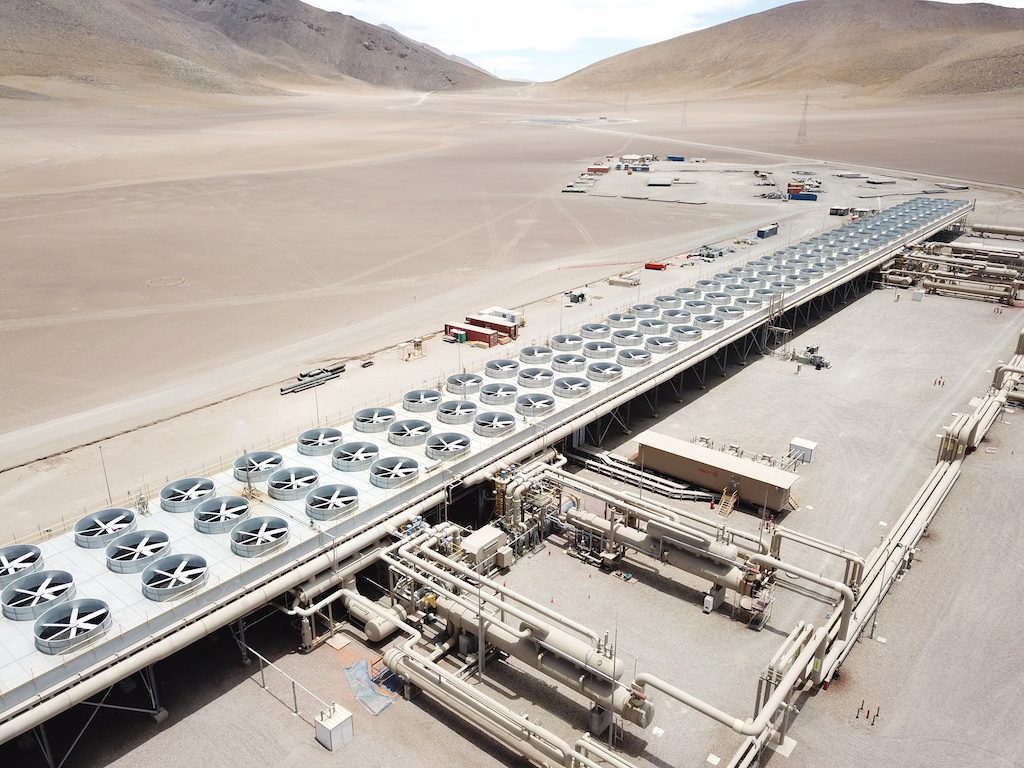What are the barriers to tapping Chile’s geothermal energy potential?

Cerro Pabellon geothermal power plant, Chile (source: ThinkGeoEnergy)
Diego Morata, director of CEGA, and Jerónimo Carcelén, President of the Geothermal Council, refer to the barriers to geothermal energy development in Chile, highlighting the lack of a government strategy in the exploration phase.
In an interview in local media, Diego Morata, director of the Center of Excellence in Geothermal Energy of the Andes (CEGA), of the University of Chile, refers to the situation of the geothermal industry in Chile, where he indicates that “… it seems to me, the train is already lost. There was a heyday and high interest of investors in geothermal energy about 15 years ago, but what could have been done about 8 years ago, when there were many companies exploring, was reduced to almost nothing. Today, the few companies that are exploring have put their information on the table and through them we get to the data we have. It is indicated by the studies that by 2050 we could be able to generate 2,100 MW (of geothermal power generation capacity), but personally I would feel very happy, under the current scenario, with reaching half that figure. Half would already be a quantum leap. ”
Along the same lines, he refers to the obstacles that the geothermal industry faces for the generation of electricity, noting that “when the geothermal boom arrived, in the 2000s, it was due to a sum of issues. First, there were years of drought and then the gas was cut from Argentina. Then, the State realized that it had no electricity and for that reason it elaborated a geothermal law to incorporate geothermal exploration. This generated a lot of speculation, because a geothermal law was used that was practically a modification of the mining law, without knowing the implications of exploration on the geothermal issue. Then, the companies requested concessions to do exploration and practically filled the entire country with concessions.”
The context at the time was characterized by very high energy prices, above USD 100/ MWh and in that scenario the opportunity was very attractive for geothermal developers.
In the same statement, Jerónimo Carcelén, President of the Geothermal Council, refers to the work on the development of geothermal plants, focusing on geological risk and high investment costs. In this regard, he points out “The main problems for its implementation are geological risk and financial risk, represented by the low probability of finding the geothermal reservoir and the high investment costs involved in exploratory drilling”
It highlights that to date there are new financial and risk mitigation instruments, all of them international, to which you can apply to mitigate the financial risks referred to the exploration phase.
The situation changes completely when the plant enters into operation, to which Carcelén indicates “… the operating costs are very reasonable, with a plant factor of 95%. This has been the experience with geothermal energy in its more than 100 years of operation in the rest of the world. There are countries like Iceland, where its penetration is so powerful, that nine out of every ten homes are heated by this type of energy and 25% of its electric matrix is ??geothermal energy. ”
Regarding the role of the State in geothermal development, Morata is emphatic in pointing out that a clear strategic line has been lacking about what the State wants and what he expects from the development of geothermal energy, both in environmental terms and in a vision of the future. In this regard, he points out “International experience says that in all countries, from the most capitalist to the most communist, in all, it has been first the State that makes the initial investment and then leaves the hand to the private ones. You must have a strategic line from the State and the private sector. Investment in geothermal energy is more expensive at the beginning and there is uncertainty when it comes to exploration. But that uncertainty can be minimized through science. ” For example, coal-fired power plants will be closing in the coming years, which produce about 2,500 MW. What do we replace it with?”
Regarding geothermal energy, it stands out that it is stable, safe, renewable, sustainable, flexible, native, with a low water and carbon footprint, allowing direct and indirect uses.
Today, Chile has a geothermal project in operation, Cerro Pabellón of 48 MW and with an additional 33 MW under construction. In addition, the Mariposa and Peumayen projects are under development, which are working on the environmental assessment and seeking financing for the development of deep exploration, starting in 2021. Other projects with initial exploratory development are Tinguiririca and Licancura III.
Carcelén indicates that in the last 10 years, the geothermal industry has invested more than US $ 500 million in exploration, development and construction of projects in Chile.
Source: our sister publication PiensaGeotermia